Measure What Matters: The Data & KPIs Every Digital & Development Agency Needs To Grow
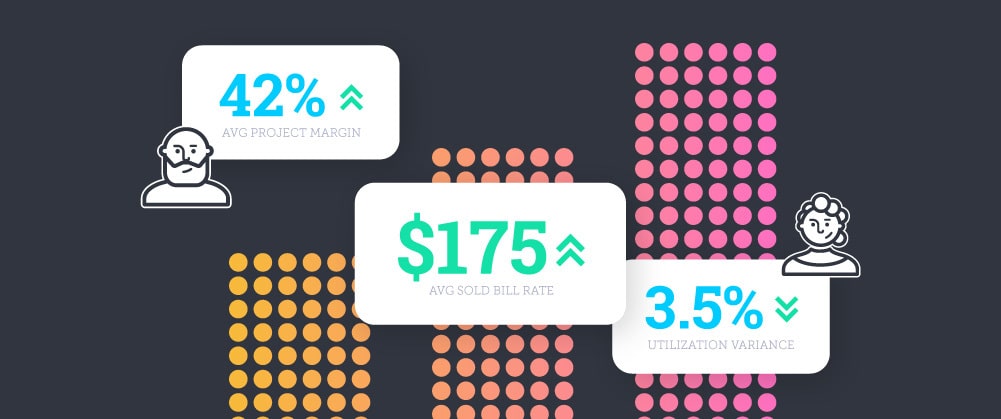
Does it feel like your business is always on a rollercoaster with too much work and not enough people – or not enough work with too many people? A lot of digital and development agencies are struggling with this today, unsure if they can sustain revenue or worried about their ability to grow. This uneasiness ties back to a lack of reliable data and foresight into the business, which unfortunately, is a very normal problem to experience in this industry. The good news for you is that we have experienced those same pains and have curated the recommended best practices from numerous industry experts around critical KPIs that will help you and your business head down a much less stressful, more profitable path. Let’s go!!!
Table of Contents
80% of all digital services companies in North America struggle to grow in a profitable way – stuck between SPI Research’s heroic and operational maturity stages. It’s almost always because of a lack of accurate, reliable, forward-looking data that’s required to grow with confidence and help your business reach the sought-after strategic stage.
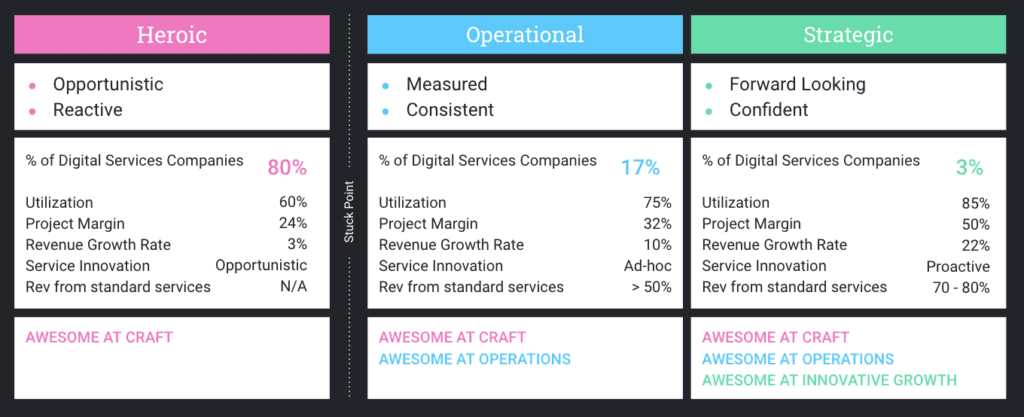
A lack of reliable, accurate data often leads to friction between sales and delivery – with both teams operating under a different understanding of how the business is performing. Sales and Marketing leads are motivated to win, pushing hard to close deals; they’re a little overly confident that they can not only reach but exceed their goals if only they bid just a little lower. Meanwhile, Delivery leads hear from their teams every day that they are already underwater and are looking to pad proposals to get more help—or they feel like they need to push work out to create some breathing room. Hiring managers, on the other hand, are left scrambling to accommodate on-demand requests in an incredibly tight, competitive market. Sound familiar?
We’re here to assure you that running a digital services organization can be much easier, and let’s be honest, way more fun, if you take a proactive approach and share the responsibility with the smart people you’ve hired to help you. By setting clear expectations for your team, regularly managing these expectations, and proactively adjusting the plan when necessary, you will achieve your goals. Yes, this is easier said than done, but it is possible to achieve… we know because we see our customers pull it off on a regular basis. 👏
Measuring What Matters
Let’s be real: leaders in the services industry often feel like they’re playing a game of Tetris (and not in a fun way). It’s an always-on scramble to figure out what resources are needed for new work, then they need to try and squeeze those same resources into the gaps between already active projects—and the shape and timing of the Tetris pieces never seem to be perfect.
But Tetris is challenging because we can only see what’s currently on the screen, right? So, what if we could see higher above the screen and know which shapes are going to drop down next? It IS possible to create a collaborative workflow and a shared, future-looking perspective across your agency or consultancy so that you don’t experience the pitfalls of misaligned perspectives.
Let’s dive into the basics around revenue operations, variance analysis, and active forecasting. 🤜🤛
Revenue Operations: Set Goals & Measure Leading Indicators for Growth
The foundation of revenue operations starts with measuring the basic activities that lead to new opportunities.
Whether you’re in growth mode or a new, young agency, the goal is generally the same. You try to fill up your sales pipeline, and once you’re fully booked, you take your foot off the gas related to generating new business to focus on delivering the work. Then, before you know it, those projects are wrapping up, and you need to get back to generating new business, so you switch back. Back and forth you go, always feeling reactive and under pressure — you want to avoid this, and we want to help you avoid this.
So, what are the things you should be doing every day and every week to make sure that you do, in fact, have a handle on performance and your ability to generate revenue? We’ve found that measuring these five things (owned by Sales) can help you identify where you might have issues that could impact revenue operations: outbound traffic, meetings held, quarterly bid to win ratio, sales qualified pipeline value, and quarterly bookings.
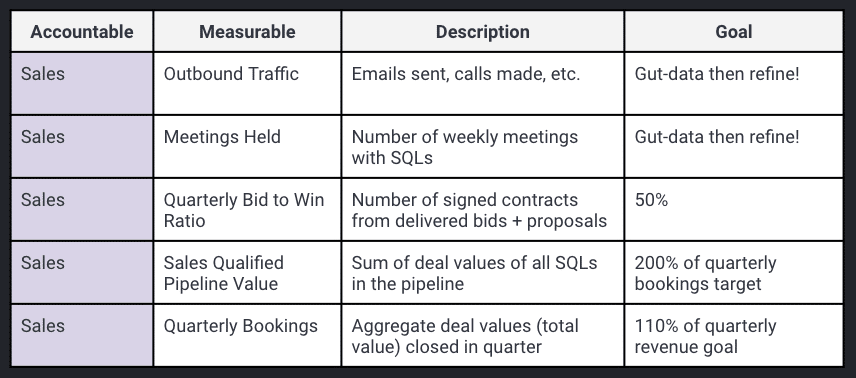
Do you know how many new deal opportunities you need in your sales pipeline in order to hit your quarterly bookings target? It might be way more than you’d think. Best practices suggest 200% (yes, you read that right!). That means if you want to book $500K next quarter, you need to have identified as much as $1M in QUALIFIED deals. This is something a lot of services companies don’t consider, let alone measure on a consistent basis.
Regularly tracking qualified pipeline deals provides an opportunity for leaders, Sales, and Delivery to come together and reassess the number and the type of deals that should be prioritized in order to drive the business forward.
Now, if you’re new at measuring the ins and outs of revenue operations, we know this can feel overwhelming. We advise you to keep it simple at the start and get your footing. Just make sure you’re tracking and assessing your chosen metrics every month as well as your sales pipeline every week, then adjust as necessary going forward.
Not sure how or where to get started? We walk through the steps for building your sales program in greater detail here — and we love discussing revenue operations and providing recommendations based on your business needs, so don’t be shy.
Variance Analysis: Build Confidence in What Drives Results
You can start to build confidence within your organization (and yourself!) by consistently measuring what you thought would happen AND what actually happened. Understanding what drives these variances is how you uncover issues in your team’s ability to plan ahead and execute consistently.
Many services organizations spend the majority of their time looking back, collecting information to understand what happened — and while it’s important to understand what happened, your focus should also be on influencing your future and creating a healthy, collaborative relationship between Sales and Delivery.
The variances we typically look at – the ones that primarily impact the health of the business – are rate, margin, and utilization.
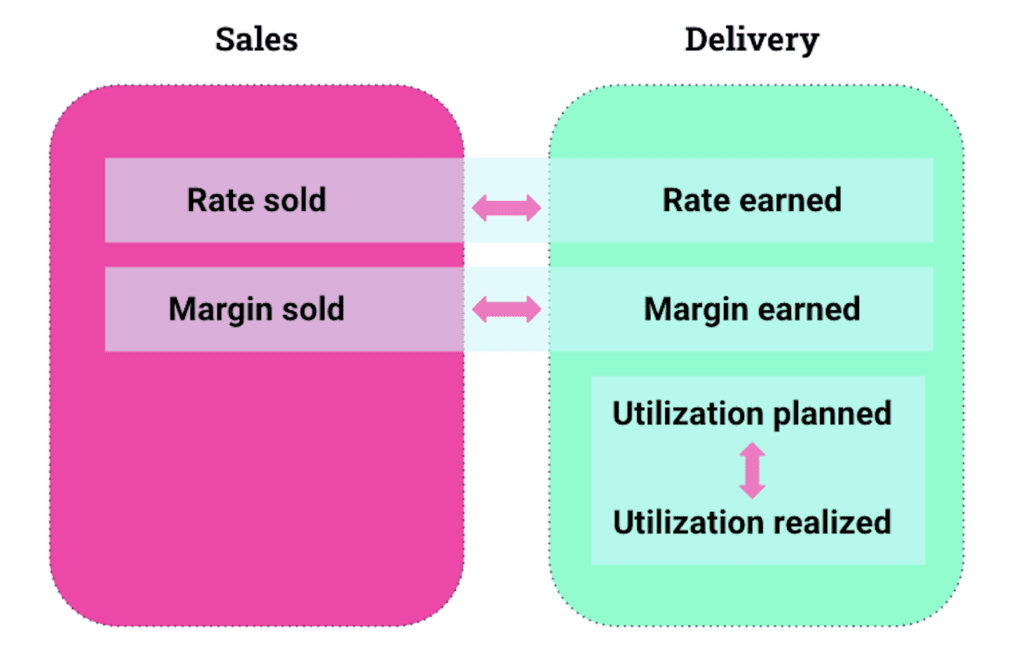
If your Delivery team is struggling to hit your margin targets, for example, you should assess if the deals were sold with a target margin that the team could actually execute on. You could be trying to drive all sorts of activities to build out qualified opportunities, but if the deal was sold with an unrealistic target margin, you’re not going to be able to make that up after the fact by leaning on the delivery team to somehow work faster. Pay attention to this metric at least monthly and review your whole portfolio to better understand not only active project performance but what expectations are being set in your pipeline as well.
If you’re new to measuring variances, however, we recommend focusing first on utilization. Utilization is kinda at the center of everything. If you can fix this metric, all the others will start to fall in line.
That said, we know utilization can be a tricky metric. Remember that actual utilization is a lagging indicator (not much can be done about it after the fact), while PLANNED utilization is at the core of the solution. Unfortunately, most people overlook this metric—they measure actual utilization compared to capacity, then struggle to diagnose why they came in under expectations. But, what are those expectations based on? Why do we think we’ll hit 60, 70, or 80% billable utilization? You can set a good goal and hope to achieve it – but let’s be honest, hope isn’t the best strategy. 🤷🏼♂️
If you want to achieve a lagging indicator of 80% actual, billable utilization, you need to plan for more. Ideally, we want a plan that accounts for 100% planned utilization, which includes both billable (client) and non-billable (company/admin) time. That means you need to have an idea of what people will be spending time on both today and in the future so you can adjust plans accordingly so they can meet their targets.
The variance, then, is the measurement between what we planned and what actually happened. As you build habits for forecasting, and frequently measure the variance, you’ll begin to trust your projection as the best picture of reality.
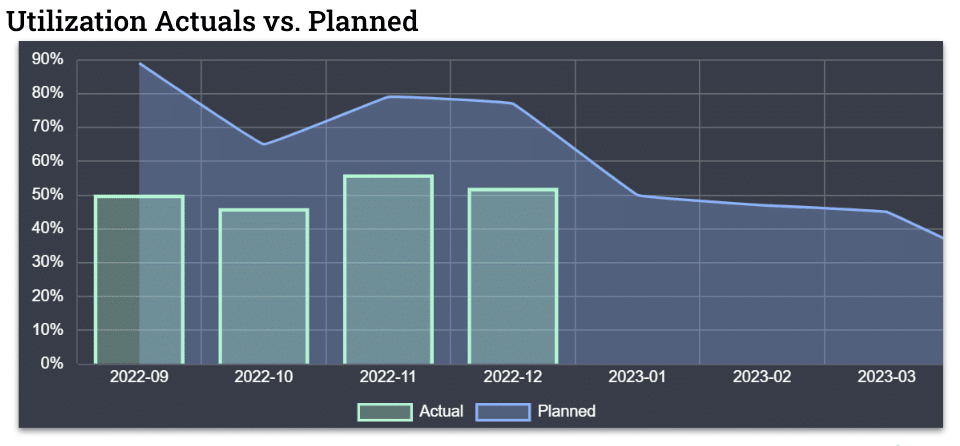
Strategic Resource Planning and Active Forecasting: Build Foresight from the Front Line
Strategic resource planning and active forecasting for an agency or consultancy – or any professional services business – is a team sport. It’s what keeps the business healthy and what allows it to scale. Sales, Finance, IT, Project Managers… everyone needs to be involved. You need to engage, empower, and place some responsibility onto all your people, especially those on the front line, to feed business-critical information up.
Here are some of the operational habits and behaviors that everybody should do:
Front line employees: We’re aware timesheets don’t have the best reputation. That’s because front line employees are asked to precisely track their time (sometimes in as little as in 15-minute increments), which can start to feel more like a “big brother” monitoring tactic rather than a communication tool that informs project managers and leads about what it truly takes to do work. Then, if employees don’t have billable hours, they feel like it will be seen as their fault, and they start to worry they’ll be seen as unnecessary or too expensive. Though in reality, if they don’t have enough billable work to do, that’s the failure of sales and leadership.
Motivate your front line employees to do their timesheets by explaining the real business value behind them. Ask them to update them frequently and be proactive. “Small” weekly tasks like this – when done on time and done accurately – make a big difference.
Project managers: Dial back the precision and focus on accuracy. Stop trying to get your teams to track time down to 15-minute increments and instead get them to submit time consistently, using larger “chunks” of time (we recommend no less than 1 hour, but ideally 2 hours (25%) of the work day). Also think about budgets and resource plans as different things than tasks and milestones, and collaborate with your fellow project managers to account for overlaps and gaps every week.
Directors and practice leaders: Always be looking forward: try looking ahead 6-12 weeks to identify gaps and overlaps (we can show you how to do this if you’re unsure how). Ask your project managers to update their resource plans on a weekly basis.
Senior leaders: Look to leading indicators – earned revenue, realized margin, billable utilization – to recognize success and adjust your plan accordingly. Do this weekly and/or monthly.
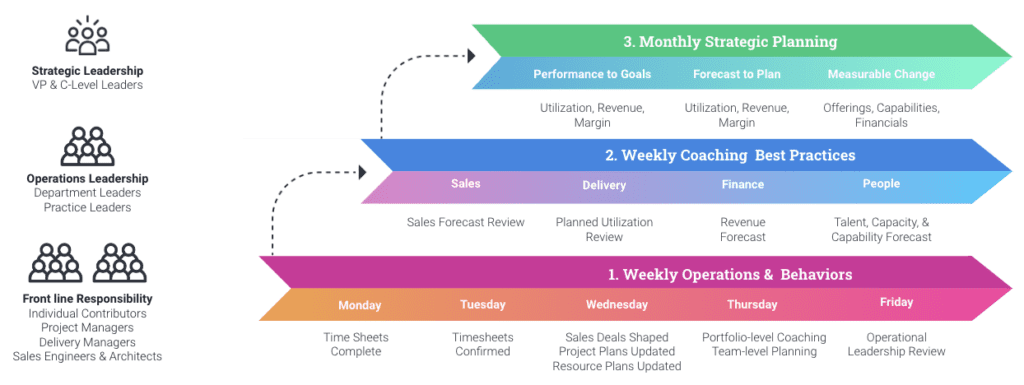
We cannot emphasize it enough: strategic resource planning and active forecasting is a team sport. Everyone is an individual contributor; they need to form weekly and monthly habits, and they need to execute them accurately in order to provide value. We have various tools, and we outline other best practices that you can leverage to support these habits in this guide.
And remember: ask the smart people you’ve hired to take responsibility and be proactive. It makes all the difference.
Want to know more? We talk through steps for smarter active forecasting in MUCH more detail here.
We’re Here to Help
Ok, ok, ok—we know this can feel like a lot. But you don’t need to go it alone. We’re here to help you assess what your business needs in the here and now AND provide guidance on how to scale your company toward that beloved strategic stage.
We can promise you this: return on investment doesn’t come from installing any software. Through our onboarding process, we’ll help you take control over the KPIs and metrics that matter most to your business, and we’ll help you empower the people on the front line, closest to the people and the customers. With Parallax, you’ll be able to coach them to think like operators and to build foresight into the business. Let’s connect!


